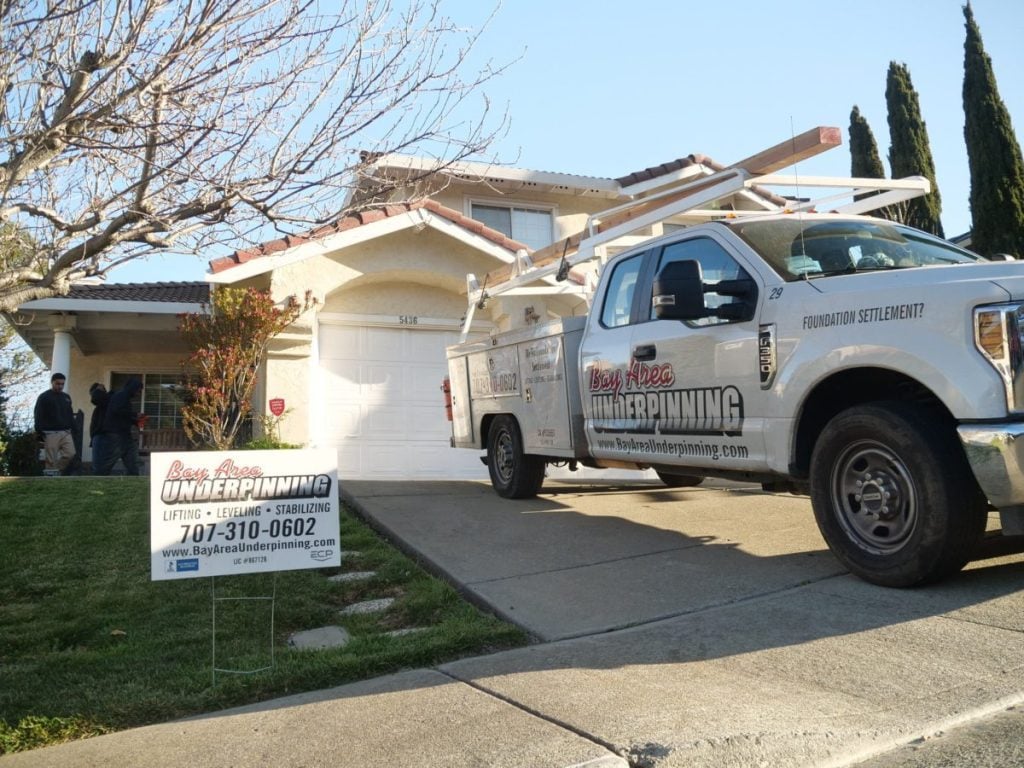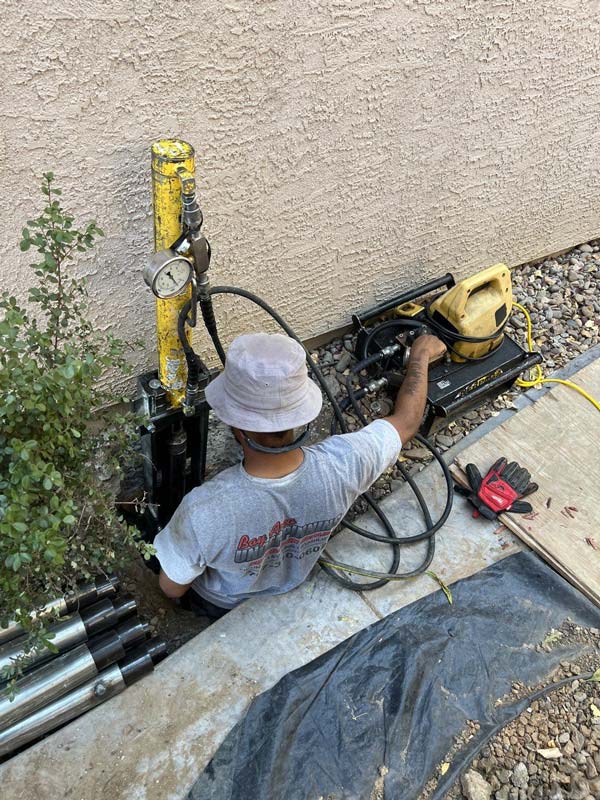Can You Live in a House During Foundation Repair?
Table of Contents
1. Can You Live In A House During Foundation Repair?
2. How Long Does Foundation Repair Take?
3. The Foundation Repair Process
4. Common Signs Of A Foundation Problem
5. How Much Does Foundation Repair Cost?
6. How To Prevent Foundation Problems
Wondering if you can live in a house during foundation repair? Well, the short answer is yes, you can. You can almost always live in a house during foundation repair.
This article will cover the foundation repair process, living in a house during foundation repair, common signs of a foundation problem, how to prevent foundation trouble, and more.
Can You Live In A House During Foundation Repair?
Yes, in most cases, you can live in a house during foundation repair. In those rare cases when you can’t, the foundation repair contractor will let you know.
You can live in a house during foundation repair because the foundation problem is fixed either from outside or in some cases from the inside. Bay Area Underpinning does its absolute best to perform foundation repairs without disturbing your daily routine.
Underpinning a foundation using push or helical piers (we talk more about underpinning below) is done outside the house. In some cases we will have install what a slab pier or crawlspace pier which may require us to bring our equipment inside the home. This is mainly for a home that has a slab foundation (meaning no crawlspace or basement). We do our best to set up the area with dust control and coordinate with homeowner’s on the noise pollution that will occur. Even in this case, the disturbance will be minimal. You won’t need to leave your home while foundation repairs are being performed.
So, living in a house during a foundation repair is the norm. Yes, there will be some noise from hydraulic pumps, generators, from the work being performed. However, in some cases you won’t notice much disturbance overall. Each foundation project is case by case depending on how much work needs to be performed.

How Long Does Foundation Repair Take?
The time needed to complete a foundation repair depends on various factors, including,
- The type of foundation problem
- The severity of the problem
- The chosen foundation repair method
- How easy is it to access the property needing foundation repair
Some types of foundation repair can be completed in a day, while others might take several days or even weeks. It depends on what’s wrong with the foundation and the repair solution.
The Foundation Repair Process
The foundation repair process depends on the type of repair being performed. If the house is being underpinned using steel push piers or helical piers, the repair process will be ever so different with each foundation project. Here are a couple of common foundation repair scenarios:
Using Steel Push Piers To Underpin A Foundation Experiencing Differential Settlement
Push piers are a common repair solution for houses experiencing a phenomenon called “differential settlement.” Differential settlement happens when a foundation settles unevenly into the soil.
These steel push piers are capable of lifting, and stabilizing your homes foundation from any future settlement. Once the piers are installed to the foundation we use a hydraulic pump to drive galvanized steel pipe into the soil until reaching competent load bearing strata or bedrock. Then the weight of the home and the foundation is distributed to the piers on solid soil.
Various things cause differential settlement, including expansive soil, erosion, earthquakes, soil that wasn’t adequately compacted before construction began, invasive tree roots, poor drainage and more. For more information about differential settlement, see Foundation Settlement.
The process for underpinning a foundation using push piers is as follows:
- The soil around the house is excavated and dug out down to the footer.
- Foundation is prepped and shaved for a clean installation
- Heavy-duty galvanized steel brackets are installed to the foundation
- A hydraulic ram drives the push piers through the brackets and down into the ground until they reach stronger soil that can support the foundation.
- Once all the piers are in place, a synchronized hydraulic lifting system raises the house.
- Final elevations are recorded in lifting areas to present recovery (if needed, in some cases we will only stabilize the foundation and perform no lift.
- The excavated soil is backfilled, and the repair is done.
- Final inspection with the city inspector or county is typically the last step in a foundation project

Using Carbon Fiber Straps To Repair A Bowed And Cracked Foundation Wall
In areas of the US where basement foundations are popular, a common foundation repair job involves repairing a bowed – and possibly cracked – basement wall using carbon fiber straps.
The leading cause of a bowed, cracked foundation wall is the build-up of hydrostatic pressure in the soil outside the foundation wall. Hydrostatic pressure builds up when there’s excess moisture in the ground because of poor drainage around the foundation. The wall will eventually bow inward and even crack if the pressure isn’t relieved. In some cases, the foundation rebar was not properly installed and could also cause some unsightly cracks or rebar corrosion. Carbon fiber straps are one way to fix a bowed, cracked foundation wall.
The installation procedure involves placing the strong carbon fiber over the cracks using an epoxy adhesive. No excavation is required depending on how deep the foundation wall is. Since the carbon fiber straps lie flat on the wall, you can paint over them after the repair is complete. For more information, see Horizontal Foundation Cracks: Should You Worry?
Common Signs Of A Foundation Problem
The following are signs your home might have a foundation problem:
- Doors and windows don’t open and shut properly
- Wall cracks, especially horizontal or diagonal cracks
- Ceiling cracks
- Floor cracks – Floor cracks that run wall to wall are a sign the foundation has moved
- Moldings that have separated from the wall or ceiling
- Stair step cracks in brick or masonry
- Uneven floors
If you see any of the above – or something else that looks suspicious – contact a foundation repair contractor or structural engineer right away for an inspection. Foundation problems worsen over time; if you wait, you’ll pay more for the repair. Save money by acting early.
How Much Does Foundation Repair Cost?
The cost of foundation repair depends on where you live, the problem and severity, and the chosen repair solution. The price might range from a few hundred dollars to fix a non-structural crack to tens of thousands of dollars to repair significant structural damage. The only way to know for sure is to have your foundation inspected by a licensed foundation repair contractor.
How To Prevent Foundation Problems
Most foundation problems are caused by water. Therefore, the best way to prevent foundation trouble is to control groundwater around your home. You can do that by:
- Regrading your yard so that it slopes away from the foundation. A yard that slopes toward the house will cause water to drain toward the foundation. This is what you don’t want.
- Make sure your gutters are free from leaves and other debris. Clogged gutters could cause water to spill over the side of the house and soak the ground around the foundation.
- Use downspout extensions to channel water at least four feet away from the foundation before releasing it.
- Don’t plant flowers, shrubs, trees, etc., near the foundation. When you water them, you’ll add extra water to the soil around the foundation.
- Install an underground downspout with a bubbler pot (also called a pop-up emitter). Water from the gutters flows into the underground downspout and toward the bubbler pot. When the pot fills with water, it pops up and releases it away from the foundation. Bubbler pots are usually located around 10 feet from the foundation.
- Install a drain tile system. A drain tile system is an excellent way to ensure excess moisture can’t build up in the soil around the foundation. Nothing beats a drain tile system when it comes to waterproofing a foundation.
If you think you’re home might have a foundation problem, and you’re in our Northern California service area, contact us today for an inspection and repair estimate.
More Resources
Publish Date:
Last Modified Date:

Our Locations
2333 Courage Dr. Suite C
Fairfield, CA 94533
1161 N Fair Oaks Ave
Sunnyvale, CA 94089



